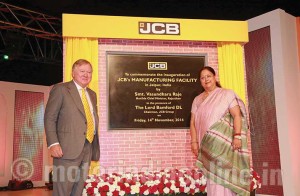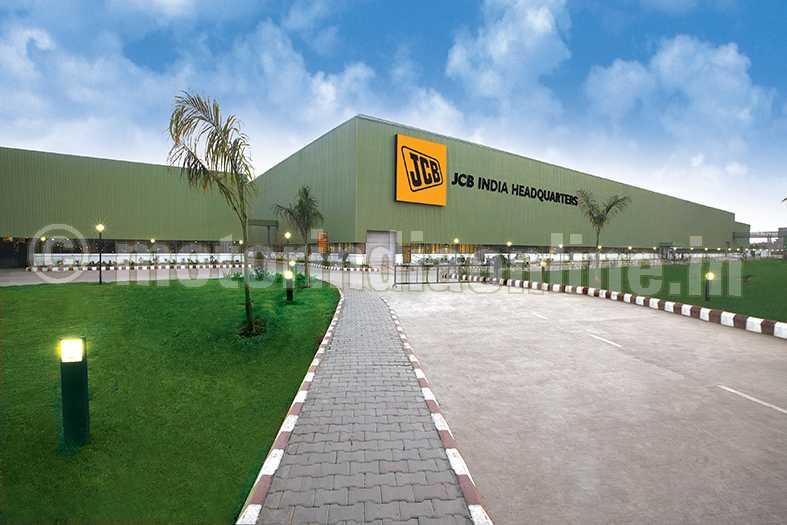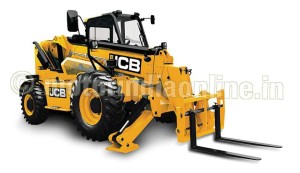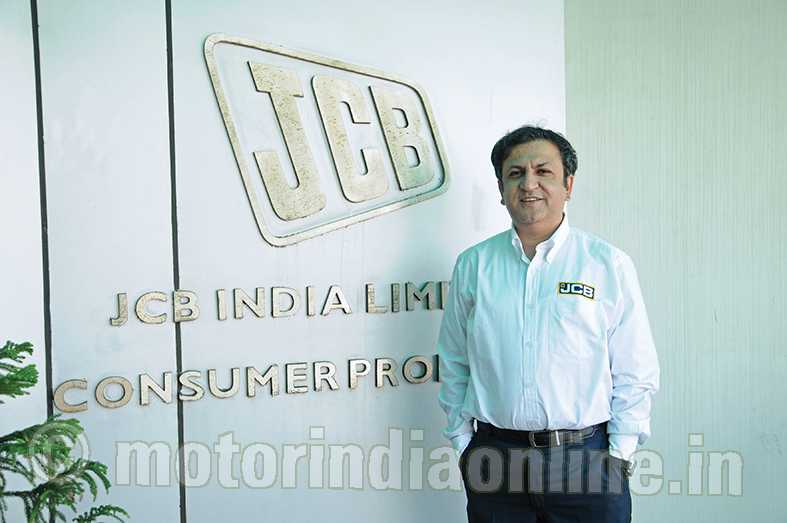JCB India, the country’s largest manufacturer of construction equipment, recently opened two new manufacturing facilities in Jaipur. Incidentally, this is the UK-based construction equipment maker’s single largest manufacturing footprint as well as its fourth and fifth plants in the country. Nearly Rs. 500 crores has been earmarked in phases for establishing the greenfield facility spanning over an area of one million sq. feet on a 115-acre land at Mahindra World City SEZ. While operating at full capacity, it will employ 1,000-1,500 persons. Component manufacturing is already underway at one of the Jaipur plants, and production of telescopic handlers and skid steer loaders for the Indian market will begin next year. The facility will also provide additional backhoe loader capacity from 2015.
The inaugural ceremony was attended by several distinguished guests such as Mrs. Vasundhara Raje, Rajasthan Chief Minister, Mr. Rajyavardhan Rathore, Minister of State for Information and Broadcasting, Mr. C.S. Rajan, Chief Secretary of Rajasthan, Lord Bamford, Chairman, JCB Group, Mr. Graeme Macdonald, Group CEO of JCB, and Mr. Vipin Sondhi, MD & CEO, JCB India.

“India is one of the ten markets in the world for JCB and is indispensable and strategic for us in the long term. Therefore, Jaipur is a vital next step that we are taking to further strengthen our position in this growing market,” Mr. Graeme Macdonald told a press conference after the inaugural ceremony.
Speaking about the Rs. 500-crore investment in Jaipur, he observed: “The inauguration of the two Jaipur factories is a significant milestone for JCB, which has been in India for 35 years and has grown to become one of India’s most respected manufacturers. From small beginnings in 1979, I could never have imagined that our family business would employ 5,000 people in India making JCBs, with thousands more employed elsewhere in the supply chain. The new factories in Jaipur mean our contribution to the Indian economy will grow, and I am grateful to the Rajasthan Government for their support in helping JCB make our investment ambitions a reality.”
Mr. Vipin Sondhi said: “Our new manufacturing footprint, the strength of the JCB brand and our complete focus on the customer means that JCB India is well positioned to build on its own “Make-In-India” credentials and continue to deliver on its promise of product and service excellence to dealers and customers in India and in our growing export markets.”
Commenting on employment, he said the company would hire 1,300-1,500 people for the new plant over the next four-five years subject to market demand.
JCB India’s three existing manufacturing facilities are the world’s largest backhoe loader factory in the world located in Ballabgarh, near New Delhi (Haryana) and two factories in Pune manufacturing fabrications and components, mainly for export, as well as state-of-the-art heavy equipment, including large excavators, wheeled loading shovels and compaction equipment. It currently employs around 3,500 people in India across its existing and new facilities. JCB is also using these extensive Indian facilities to export to Eastern Africa, the Middle East and South-East Asia.
“After becoming a formidable player in the domestic market, we are now gradually increasing our exports from here”, stated Mr. Macdonald.
On the current toplines, Mr. Sondhi said the gross revenue of JCB India was Rs. 5,500 crores accounting for 20 per cent of the global pie. Without giving a forward-looking forecast, he said, “this year, we are expecting a slight recovery and are hopeful of a double-digit CAGR from next fiscal onwards.”
The positive outlook comes on the back of an AT Kearney report that claims the total size of the earth-moving equipment industry at $3 billion as at the end of 2012 and is estimated to reach $20 billion by 2020.
Meanwhile, JCB India disclosed to MOTORINDIA that its R&D centre in Pune, which has a headcount of around 300 engineers, is contributing not only for the domestic market but also for its worldwide operations. Also known as the ‘India Design Centre, it is one of the most advanced research and development facilities focusing on state-of-the-art products and design engineering and rigorous quality enhancement. Spread over 100 acres, it is one such location that caters to design solutions across engineering teams of all JCB business units in 14 locations across the globe. The centre helps in developing products such as styling, design engineering and vehicle test & evaluation. The facility has an engine development centre (EDC), vehicle design & development facility, testing facility and a prototype centre.
The Indian design centre is a critical element to any product development within JCB globally. In addition to designing India-specific products it is also going to customise products from JCB’s global portfolio for the Indian market. Poised to be an integral part of JCB Group’s aspirations, the centre is aimed at further accelerating local content development and enables the company to respond even more quickly to changing customer needs across the world.
“The R&D Centre will further facilitate the development of India as our global hub for manufacturing and engineering of various machines. JCB’s India Design Centre has such a lot to offer not only for emerging markets but developed markets too. We have a bunch of young, passionate, and creative team of engineers there learning and designing things. Besides some front-end activities, the centre also supports all back-end operations like Computer Aided Engineering (CAE), Computer Aided Design (CAD) and help the R&D work taking place across JCB’s global portfolio,” Mr. Graeme Macdonald said.
JCB has one of the largest distribution networks, with 60 dealers and over 600 outlets operating in India employing over 5,500 employees. It has strategically set-up large warehouses in Pune, Chennai, Faridabad and Kolkata.
JCB India hopeful of infrastructure development boosting fortunesIt’s a known fact that JCB has become a generic name for earth-moving equipment in India in the same way that Bisleri is associated with bottled drinking water and Maggi with instant noodles. Just before the plant inauguration, MOTORINDIA got the privilege to interact with Mr. Amit Gossain, Executive Vice President – Sales, Marketing and Business Development JCB India, and President – ICEMA. Although he is cautiously optimistic about the growth of the domestic construction equipment industry, he is quite upbeat on the company’s new product lines and technologies that will shore up its bottomlines. He is quite confident of not only maintaining the company’s current marketshare of over 50 per cent but also enhance it further in the domestic construction equipment industry. Edited excerpts: How is the business environment in the Indian construction equipment industry after the new government assumed power at the Centre? Firstly, the overall market has been very challenging for the last three years. The projects that have been announced (by the previous government) have not been implemented. Now, with the new government with a massive majority, there is a lot of hope for revival of these projects. With the evidently positive sentiments, there is some movement happening. But whether such forward-looking policies get fully executed remains to be seen. The Government is making the right moves and is looking at the country’s infrastructure very seriously, besides taking initiatives like solid waste management through the ‘Swatch Bharat’ campaign. If these things move in the right direction, the economy will definitely grow. What is the overall size of the Indian construction equipment market and what’s your marketshare? The size of the domestic construction equipment market is approximately 50,000 units per year and our marketshare is approximately 50 per cent of the served market. How is the off-highway segment performing currently? If you are referring to construction equipment, it is directly proportionate to the rate of infrastructure growth. Even though the sentiments have been positive, infrastructure development has almost been stalled. Sentiments have definitely improved leading to an uptake in volumes. This is on the back of the new-found hope that some projects will take off in the near future. Even though there is a distinct uptrend, absolute growth will happen only when the infrastructure projects are kick-started. So, has JCB lined up any new product launches? We have recently introduced the Loadall. The concept of Telehandler is yet to take off in India. It is a machine that can handle, lift or load aggregates in palletised as well as in open load form. The machine comes with a variety of attachments that make it truly versatile and safe. The skid steer loader is a versatile machine that is specifically designed to operate in narrow and restricted areas. It has the potential to contribute much to solid waste management. Like the Loadall, the skid steer loader also comes with a host of attachments to enable it to have multiple applications. We have also introduced an advanced Telematics technology known as “Livelink”. JCB Livelink keeps you connected to your JCB machine at all times. It basically operates on the SOS principle of Service, Operation and Security. Are your products 100 per cent indigenised? The indigenisation level is different for different product lines. However, for certain new product lines, we import a few components. Which are the key markets where you are exporting your products to? Yes, we do export our products to markets similar to India such as SAARC, Africa and some parts of America. How is the Indian customer different from your overseas ones? Customers all over the world today care more for productivity, efficiency, reliability and quality, and customers in India are no different. JCB manufactures all machines based on the company philosophy of One Global Quality. This means the equipment we manufacture in India can be used in any part of the world. However, the operating conditions in India are quite arduous and, therefore, the customer demands differ. The JCB objective is to fully understand the customer requirements and accordingly design and manufacture the machine. You have rolled out power and hand tools nearly an year back. How is the response for it? Our intention to introduce tools was to give the right quality ones to our customers. And we have received an overwhelming response from our customers. JCB has specifically designed a range for the Indian market to ensure their robust usage and longevity, covering power tools, including angle grinder with back & side switch, circular saw, planer, marble cutter, electrical drill, rotary hammer, etc. The hand tools range includes best-in-class tools storage solutions, specialty tool sets, cutting & pipe tools, measuring & layout tools, striking & finishing, and general tools for automotive and industrial applications. These tools will also pave way for both higher efficiency and income for the manual workers. It is primarily a brand extension and part of our quality consumer products portfolio. Besides telematics, what are the other significant trends in this industry? In the past couple of years, we have seen some major technological reforms in the industry as it not only ensures better productivity but also guarantees work completion in a much safer manner. Safety is of paramount importance for JCB, and we design products which are safe, reliable and comfortable. For instance, JCB skid steer loader is the safest in the world because of the side door entry which reduces the risk of mishaps. Secondly, customers are now looking for machines which provide the best-in-class fuel efficiency, and JCB, as always, continues to lead in this area. JCB machines are fitted with the JCB “ecoMAX” engine regarded as the most fuel efficient, high torque at low rpm engine in the industry which provides lower operating cost to JCB customers. JCB products are the most fuel-efficient machines in the market: The JCB backhoe loader offers savings of Rs. 2.6 lakhs a year over its competitors; JS 205LC has a potential to save Rs. 1.3 lakhs a year on fuel cost; and the 430ZX provides savings of Rs. 2 lakhs over three years. Apart from innovative products, our customers also look for quicker availability of parts. What is the company’s projected growth for this year? We are certainly positive about 2014, given the notable reforms proposed by the new Government, and I’m certain our company’s growth will be in line with the industry growth. Lastly, since you are chairing ICEMA, how are you serving the interests of this industry? Firstly, we are approaching the Government to set up a local test centre for all the OEMs. Secondly, we are also working towards setting up skill development centres in the country. ICEMA’s proposal for the Sector Skill Council has been approved by NSDC. It has recently been renamed as the Infrastructure Equipment Skill Council (IESC). The Governing Body of the Council includes representatives from equipment manufacturers, construction companies / associations, the Department of Heavy Industry and NSDC. IESC has already started its operation with ICEMA support. With the full backing of the members, the Council will spearhead the skill development initiative of the industry. If you look at the requirement for trained operators, you will notice that every machine requires at least two people to operate it. So if we have four lakh machines on the road we require eight lakh trained people to efficiently operate them. Therefore, the demand is huge and we need to bridge this gap. Thirdly, as an industry body, we also talk about technologies such as emission standards for the future. Our industry is quite active on this front, and the members play a significant role in our development. Recently, we also had a conference with the Rural Ministry to develop roads in the countryside and the technology required to promote it. |



